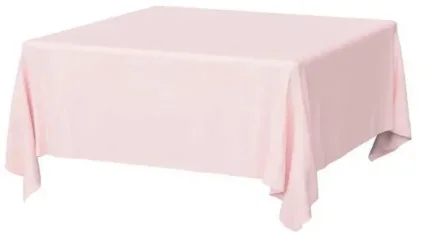
Information supplied
1. The problem only affects white, 100% polyester tablecloths and napkins.
2. The pinkness develops gradually over about 10 weeks.
3. The pinkness looks more obvious under laundry lighting than in natural daylight.
4. Cotton and polycotton textiles are unaffected.
Technical cause
There are two possible causes of this problem:
1. Accidental inclusion of a red napkin (either paper or textile) in the wash. That is almost certainly not the problem here, because this would have caused a sudden change in colour and not the gradual change reported here.
2. Conflict of two different optical brightening agents (OBAs) – the one originally put onto the polyester fibre and the one in the laundry detergent. This is almost certainly the problem described here. It is characterised by the steady (rather than sudden) build-up of pink discoloration, and the different appearance of the problem under light containing different amounts in the ultraviolet spectrum (e.g. light in the laundry workroom vs. natural daylight).
The function of the optical brightening agent is to react to light energy in the invisible ultraviolet wavelengths and convert this into visible white light. This enhances that apparent whiteness of the textiles so that they almost glow.
The OBA incorporated by the textile manufacture can either be applied in the molten polyester before extrusion or it can be applied in finishing, where it locks onto the dye sites on the fibre surface. The OBA applied in laundering comes from key ingredients in the detergent used.
Usually, if good quality OBAs are used in manufacture, there is no interaction between the two OBAs and the laundry OBA replaces in every wash the small loss of the manufacturer’s OBA with every wash and use cycle.
In the problem described, the symptoms point to an unsuitable OBA applied in textile manufacture, rather than in the detergent (because only this batch of textiles appears to be affected).
The vast majority of textile suppliers to the contract and rental laundering markets utilise OBAs which do not give this problem, which is why it occurs so infrequently.
Suggested resolution
1. OBAs are frequently destroyed by sodium hypochlorite (‘chlorine bleach’), but this requires quite large concentrations, and it can cause different, unexpected tinting. It is unlikely to be useful here.
2. A better solution would be to apply an OBA quench chemical in a high temperature wash process. Suitable products are available from textile finishing specialists such as Chromatech in Leeds.
3. Roger reports having had some success with sodium dithionite as an OBA quench, which is readily available to launderers as a reducing bleach under the trade name Hydros. This can release a strong odour of hydrogen sulphide, which is poisonous at high concentrations, so it is vital to follow the supplier’s safety recommendations. A sensible additional precaution in every instance is only to use it in a well-ventilated workroom at the end of the working day, with no personnel present. Hydros should not be used in washing machines as it attacks metal. It can be very effective used as a soaking treatment applied using a suitable plastic container. It is generally safe on white textiles and in the case of white 100% polyester items, if necessary, Hydros can be used as a saturated solution.
4. In order to keep this batch of textiles white going forward, it might be prudent to switch to a colour detergent (which contains little or no OBA). The textiles would no longer look bright white, but once you have got rid of the tint, they would at least be useable.






